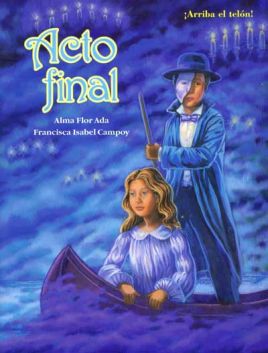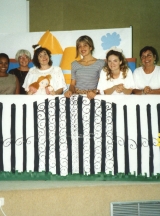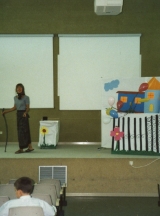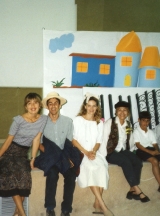Acto final
Acto final
BOOK DESCRIPTION
This theatre anthology includes four plays. La niña que riega la albahaca y el príncipe preguntón is a delightful play by Federico García Lorca, one of the greatest playwrights in the Hispanic theatrical tradition. Aventura en la Antártida [An Adventure in Antartic] by Adriana Alarco Soldi and Haraganoff, El Pirata [Haraganoff, the Pirate] are contemporary plays created especially for children. La doncella guerrera [The maid warrior] is the dramatization of a famous medieval ballad.
The book also includes four sections that will teach children about various aspects of the theatre, and will facilitate their involvement with different forms of staging a play: Pasos a seguir en un montaje teatral. Las máscaras. Los títeres. Teatro de sombras.
USING THIS BOOK
The value of involving children with theatre are multiple. Plays can be an excellent tool for promoting the leadership skill of being able to speak in front of a group. Since they offer children the opportunity to utilize words and language registries they may not have other opportunity to use, plays can be strong vehicle for vocabulary and language development.
When used for choral reading plays can strengthen reading skills. In addition, acting in a play enhances children’s self-confidence and self-esteem while providing opportunities to learn about one’s self and others. Most importantly, putting on a play, no matter how simple, promotes the values of collaboration and solidarity.
To read more on the significance of theatre click here: Let’s Raise the Curtain! The Benefit of Theatre in the School and for suggestions on its use in the classroom read the section “Plays and Dramatic Games” in Chapter 3 of A Magical Encounter: Latino Children’s Literature in the Classroom and for dramatic responses to books, the section “Promoting Dramatic Expression” in Chapter 4 of that same book.
AUTHOR’S NOTE
Ensuring that children have access to read and act in plays has always been one of my basic concerns. Even if it is done with great simplicity acting in a play can have very positive results. It certainly was so for me. Encouraged by my extraordinary sixth grade teacher, Dra. Rosa María Peyrellade, I wrote my first play which we performed in class. As a high school student I wrote three plays, and while very simple, my classmates performed them with enthusiasm. We invited the High School Faculty of the Instituto de Camagüey to the premier of one of them, which I entitled La sonámbula or The Sleep-walker. Even though some of the professors did not enjoy the criticism to their very traditional pedagogy which was part of the performance, there was enough interested public that we rented the best theatre in town, el Teatro Principal to give a couple of public performances.
When I became a High School teacher at the Colegio Abraham Lincoln in Lima, Perú, I invited my students to do theatre and we had great fun doing so!
My mother, a coordinator for FLES [Foreign Language in the Elementary School] in Atlanta, Georgia, used theatre very effectively in the teaching of Spanish, and wrote a number of plays that were performed by children and broadcasted via the district TV station.
As a teacher educator in the United States I have continuously emphasized the use of theatre. I have had the privilege of having my mother co-direct with me three different performances of Historia de una muñeca abandonada, by Alfonso Sastre during three summer courses: at the University of Texas, at El Paso, in Philadelphia, and in Puerto Rico. I was later able to continue to invite teachers to perform this outstanding play, in Chicago, through the Associate Colleges of the Midwest, and in Madrid, both at the Universidad Complutense and at the Fundación José Ortega y Gasset. This play is included in the anthology Ensayo general in this collection.
I am convinced that one is better able to teach something one has enjoyed doing. And just as Isabel Campoy and I emphasize, in our courses in Authors in the Classroom, that teachers who create their own books will be better able to get their students to become authors, I believe that encouraging teachers to do theatre and experiencing the richness of the process would better allow them to incorporate plays in their regular teaching.
For a delightful anecdote that shows the magic of theatre click here: Let’s Raise the Curtain! The Benefit of Theatre in the School.
You can also find more about my personal experience with theatre in the section “It’s Play Time!” in Alma Flor Ada and You volume II, published by Libraries Unlimited.
ABOUT ¡CURTAINS UP! THE CIELO ABIERTO THEATRE COLLECTION
Each of the seven anthologies in this series offers a variety of plays well-suited for either reading aloud or for full-scale performance. For the early grades, Alma Flor Ada and F. Isabel Campoy have created original adaptations of traditional children’s stories. Familiar tales are retold in the form of plays, choral poems, and theatre games, inviting children to explore movement, characterization, and imaginative play. The use of traditional Hispanic folklore, woven into the dialogue, enhances the cultural setting in which the stories have been recast. For the older grades, a selection of the best plays written for children throughout the Spanish-speaking world has been carefully assembled.
The anthologies are:
- Primer acto [PreK-2] 48 pages
- Risas y aplausos [K-3] 48 pages
- Escenas y alegrías [1-4] 48 pages
- Actores y flores [3-6] 64 pages
- Ensayo general [4-7] 80 pages
- Saludos al público [5-8] 96 pages
- Acto final [5-8] 96 pages
Teachers have found the anthologies in this collection both inviting and inspiring.
READERS’ RESPONSES
If you have enjoyed reading or sharing this book, I would very much like to hear from you. Please click here to send your comments.




